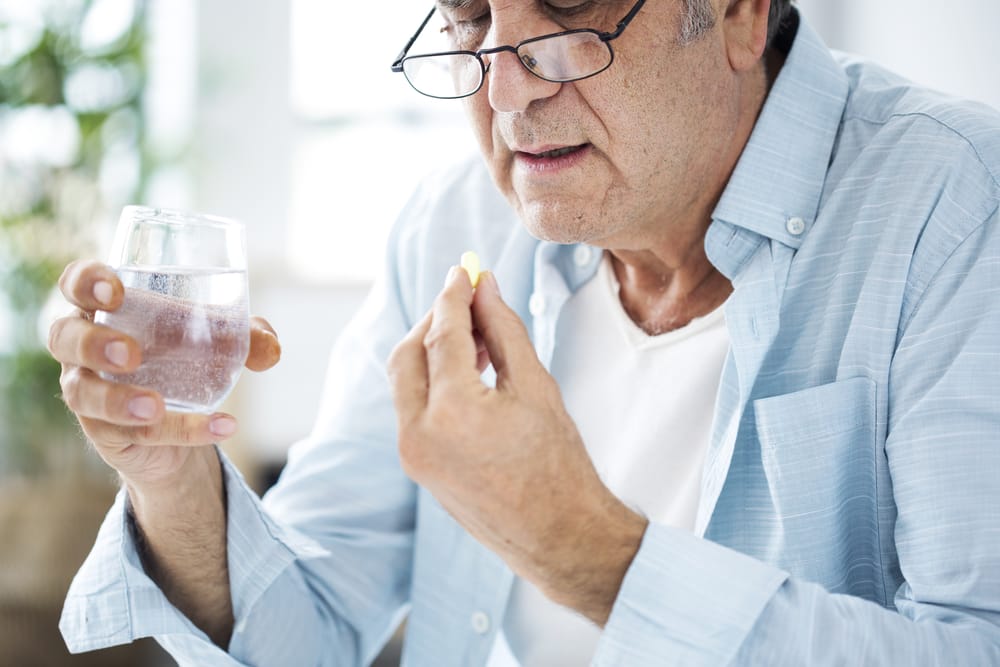The number of senior citizens with drug addiction is on the rise in the United States, and prescription painkillers, such as hydrocodone and other opioids, play a major role in drug problems among the elderly. Opioid painkillers are the fourth most commonly abused substance among senior citizens in the U.S., following close behind alcohol, marijuana and stimulants. According to an international study of opioid use disorders, adults aged 50 and older who abuse opioids are more likely to die prematurely, and the reason may be a higher risk for overdose. Prescription opioids were involved in a significant number of the 64,000 drug-overdose deaths in the U.S. in 2016, and senior citizens were among the roughly 3 million people in the U.S. with hydrocodone addiction or other opioid/opiate addiction.
What Is Hydrocodone?
Hydrocodone, the most commonly prescribed opioid painkiller in the U.S., is a semi-synthetic narcotic that is used as an analgesic (pain medication), typically combined with acetaminophen. It is sold as a generic or under the brand names Vicodin, Hysingla, Zohydro, Norco and Lorcet, among others.
How Hydrocodone Addiction Happens
Like opium and opiates, opioids have highly addictive properties. Even when prescribed by a doctor, hydrocodone pills can lead to physical tolerance and dependence if taken at higher doses or for too long. The development of physical tolerance prompts people to start taking a higher dosage than prescribed in order to feel the same level of pain relief they experienced at the beginning. However, once tolerance to an opioid like hydrocodone develops, pain levels may spike as soon as a person stops taking the medication. This increase in pain is a withdrawal symptom that, if not well-managed with a transition to non-opioid painkillers and other therapies, leads many people to renew their opioid prescriptions and bump up their dose, setting up a cycle of dependence and withdrawal that can lead to addiction. The Centers for Disease Control and Prevention (CDC) found that long-term use of opioid painkillers doesn’t necessarily produce superior effects to alternative measures, such as non-addictive painkillers combined with physical therapy or another pain-management modality like acupuncture or massage. Since opioids have been found to have comparable (or lower) efficacy than other painkillers over a long course of treatment, transitioning to a non-opioid painkiller and supportive therapies for greater long-term relief and comfort is optimal. Unfortunately, many people don’t make this transition. Their doctor may not closely supervise their treatment, or doesn’t explain that the spike in pain they experience between hydrocodone doses can be an opioid withdrawal symptom that indicates they need to be weaned off the drug and not an indication that they need more of it.
Managing Pain While Avoiding Hydrocodone Addiction
To manage pain and avoid addiction to prescription drugs, good communication with the prescribing physician at the time of initial prescription is necessary to ensure they don’t write a hydrocodone prescription for longer than seven days — studies show that after about five days, addiction to opioid painkillers becomes more likely, particularly if the dose is too high. It is best to request a shorter four- or five-day dose of an opioid painkiller, and then request an alternative to be used after that. Given the busy, complicated nature of the healthcare system today, the burden is usually on the patient or the patient’s advocate to ask for physician authorizations and referrals to physical therapy or other complementary therapies and modalities (i.e., massage, acupuncture) that will help them manage their pain in healthier ways. The burden is also on the patient to work with Medicare or their private insurance company to determine which alternative medications and therapies are covered in their healthcare plan. Managing these details can be challenging for older adults, and the responsibility of handling prescriptions and other medications usually falls on a relative or other caregiver. The caregiver is likely also the one to coordinate complementary pain therapies and transport the loved one to the additional appointments, which is worth the extra effort if it ensures an older loved one doesn’t become dependent or addicted to hydrocodone or other pain medications.
Hydrocodone Addiction Treatment
If and when hydrocodone dependence or hydrocodone addiction occurs, it will likely be necessary to undergo detoxification, or detox at an addiction treatment facility. A few days of medically assisted detox can help restore balance to the body while providing alternative pain relief. Hydrocodone withdrawal is challenging, and symptoms can include increased pain, confusion, depression, muscle and joint pain, heart palpitations, sweating, diarrhea, nausea, hypertension, fever and insomnia. Research-backed medications may be used during the detox period to help ease these symptoms. The next phase of addiction treatment typically involves helping the client find alternative ways to deal with chronic pain as they return to good physical and mental health. Support and training in alternative coping methods and modalities are usually provided during treatment, with the goal that the client can rely on a new course of pain management that is effective and supports their well-being in recovery. Sources Prescription Drug Abuse among Older Adults. Olivia Dean. AARP Public Policy Institute, August 2017. https://www.aarp.org/content/dam/aarp/ppi/2017/07/prescription-drug-abuse-among-older-adults.pdf CDC Guideline for Prescribing Opioids for Chronic Pain — United States, 2016. https://www.cdc.gov/mmwr/volumes/65/rr/rr6501e1.htm Opioids – National Institute on Drug Abuse (NIDA), 2017. https://www.drugabuse.gov/drugs-abuse/opioids Key Substance Use and Mental Health Indicators in the United States: Results from the 2016 National Survey on Drug Use and Health. SAMHSA, 2016. https://store.samhsa.gov/shin/content/SMA17-5044/SMA17-5044.pdf Hydrocodone – Drugs.com, 2017. https://www.drugs.com/hydrocodone.html A Day in the Life of Older Adults: Substance Use Facts, May 2017. https://www.samhsa.gov/data/report/day-life-older-adults-substance-use-facts Emergency Department Visits Involving Illicit Drug Use by Older Adults. The DAWN Report, Drug Abuse Warning Network (DAWN), September 2010. https://oas.samhsa.gov/2k10/DAWN015/IllicitAbuse.htm

